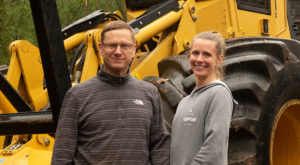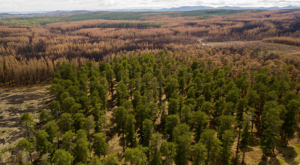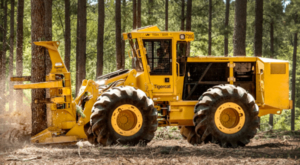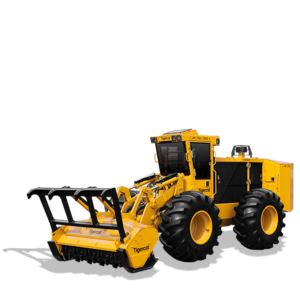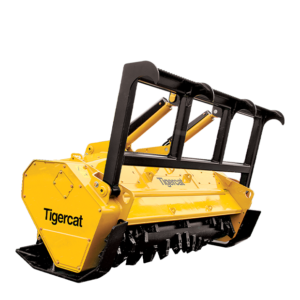– Bre Elbourn
Hill Country, Texas
Welcome to Texas Hill Country – where the land is dry and the brush is thick. Texas heat coupled with sparse rains, means vegetation must be resilient in order to survive. Ashe juniper (belonging to the cypress family but commonly referred to in Texas as cedar) is well adapted to these harsh conditions and without intervention, poses a threat to other native vegetation.
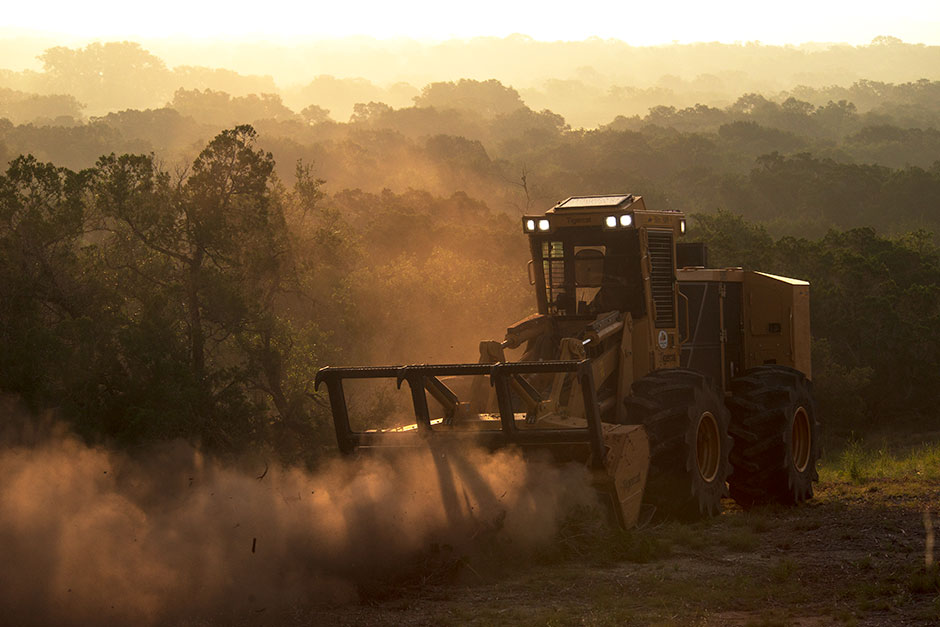
The Tigercat M726G mulcher with 4061 mulching head operating early morning in Hill Country, Texas.
THEY LISTEN TO THE CUSTOMER AND TAKE THAT KNOWLEDGE AND IMPLEMENT IT. WE DON’T GET THAT ANYWHERE ELSE.
In Texas, mulching has become the intervention of choice for landowners battling cedar on their ranch lands. Recognizing a need for brush clearing services in their community, husband and wife Stan and Pam Hegener started Cedar Eaters™ in 2001. Now co-owned with their son, Spence Hegener, Cedar Eaters of Texas offers mulching and land restoration services across the state of Texas – occasionally breaking into bordering states. BTB caught up with Spence to learn more about Cedar Eaters’ operations and how the M726G mulching machine is tackling the Texas terrain.
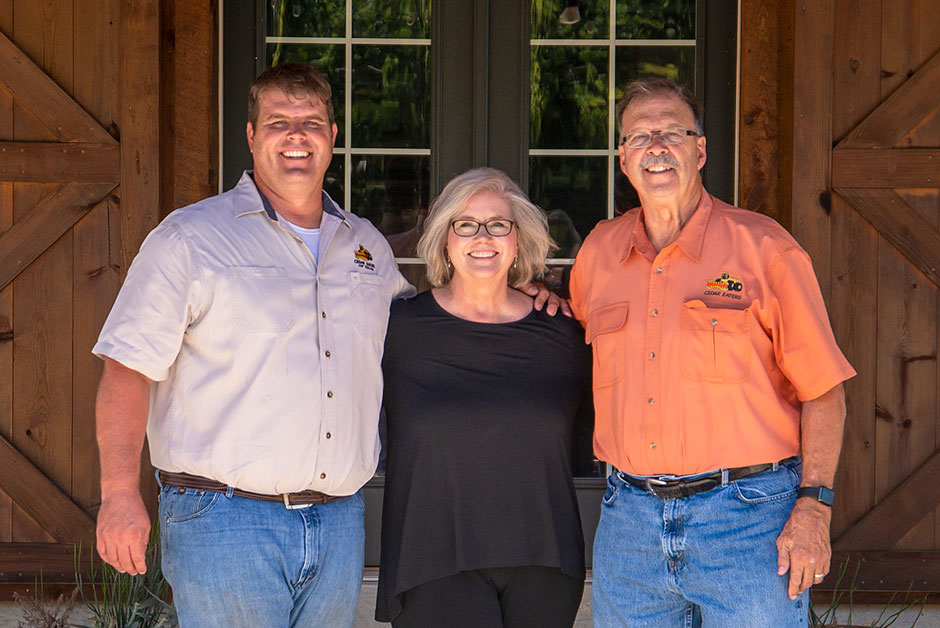
The faces of Cedar Eaters. L-R: Spence Hegener, co-owner and operations manager; Pam Hegener, C.O.O./majority partner; Stan Hegener, president.
Operations
Located in Comfort, Texas, the Cedar Eaters base of operations, including the mechanical shop and offices, backs onto the Guadalupe River on a gorgeous 20-acre property. Pam and Stan’s personal home sits at the back of the property, overlooking the river. A beautiful ponderosa pine barn – with an interior that looks more like a high-end cottage – is home to the administrative offices. It is a relaxed environment where employees are even able to bring their dogs in for the day. An in-house property maintenance crew keeps the grounds in peak condition.
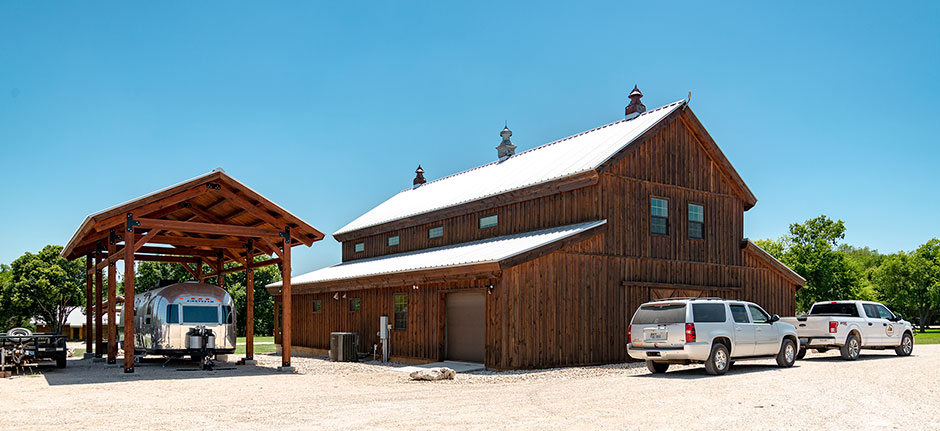
Cedar Eaters operations in Comfort, Texas is on a 20-acre property overlooking the Guadalupe River.
Totally focused on land restoration, Cedar Eaters offers services such as cedar and brush mulching, mesquite grubbing, and hand crew cutting and chipping for both residential and commercial properties. “But most of what we do is selective clearing of cedar for ranch owners, because cedar trees are viewed as a bad tree in our neck of the woods,” Spence explains.
Cedar Eaters operates four Tigercat M726E mulchers with Fecon heads, one 470 track mulcher, and two M726G mulchers equipped with the new Tigercat 4061 head. Spence explains that by sticking to one brand of mulcher, parts and tools can be swapped out interchangeably. If there is a mechanical issue on one machine, mechanics can keep an eye out for similar issues with other machines and perfect the repair process – reducing the overall downtime required to service the fleet. “Buy one kind of machine, stick with that machine,” says Spence. “Tigercat was the best quality machine after being through all the other ones; that was what we went with and decided to keep building on.”
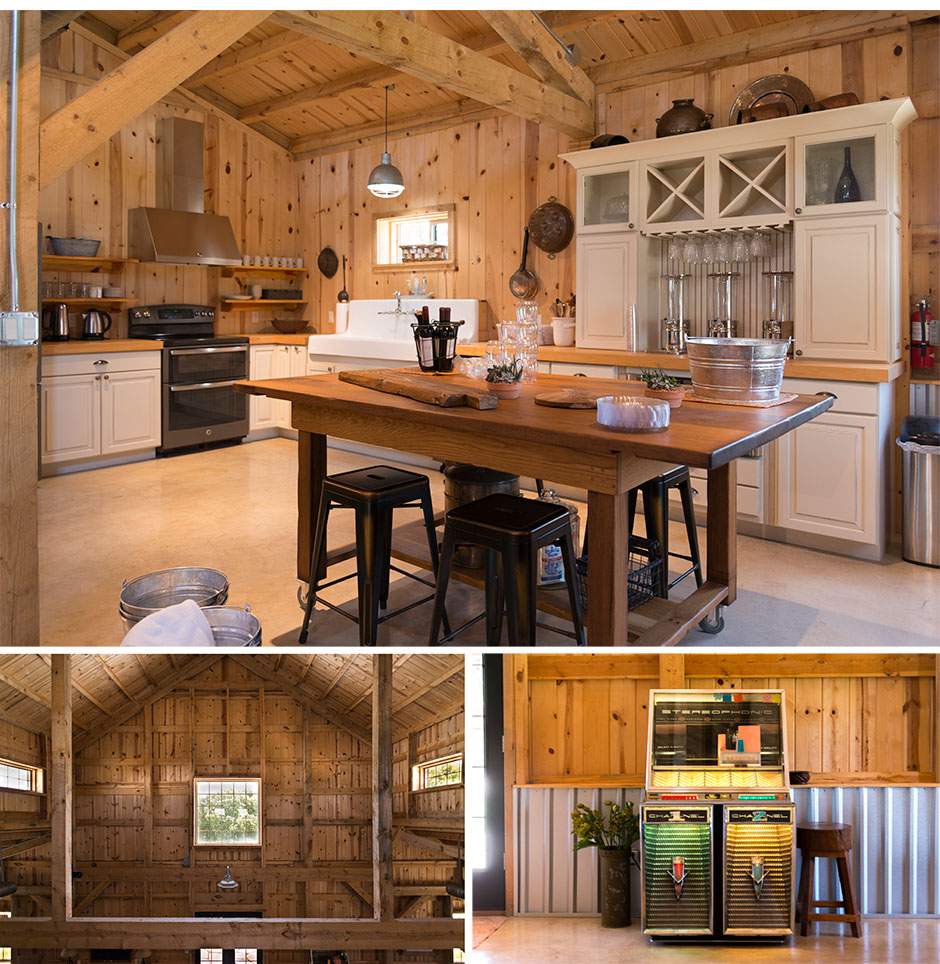
On the main floor of Cedar Eater’s administration offices, is a beautiful kitchen and sitting area complete with an old-school jukebox and Pam and Stan’s offices. Upstairs is an open-concept administration area.
Spence notes that another reason he chose and then stuck with Tigercat is because “they listen to the customer. For example, there’s a lot of things that I think I may have had some input on with this head! Or I’ll ask for something to be done on the machine, and then I look down on some of the newer machines and those things have been taken care of. Access to different areas where it was a pain in the butt in the earlier models, now it’s easier to get into them. Just little things like that. They listen to the customer and take that knowledge and implement it. We don’t get that anywhere else.”
How they began
Pam and Stan Hegener first made their name in the industrial construction and pipeline industry in Louisiana. With Pam’s background in HR and business management and Stan’s in industrial construction and operations, the two successfully managed a large industrial construction company, with over 500 employees, for over fifteen years.
In 2001, the Hegeners left the industry in Louisiana, purchasing a ranch in Texas Hill Country with the intention to retire there. Stan found himself competing with brush on their own ranch – specifically cedar. Having worked in the industrial construction industry, the Hegeners were familiar with mulchers, which are commonly used by pipeline contractors for ROW (right-of-way) clearing.
Pam and Stan decided to buy a small mulcher of their own for personal use. After clearing their own land, Spence tells us they “cleaned a friend’s ranch up, and it kind of got out through word of mouth that we were cleaning properties up around us in the Hill Country.” Thus, Cedar Eaters came to be.
Having started out with just one small mulching machine, Cedar Eaters now employs around 25 people with seven Tigercat machines in their eight-machine fleet. While Spence has taken hold of managing day to day operations, Stan and Pam still have yet to actually settle down and retire.
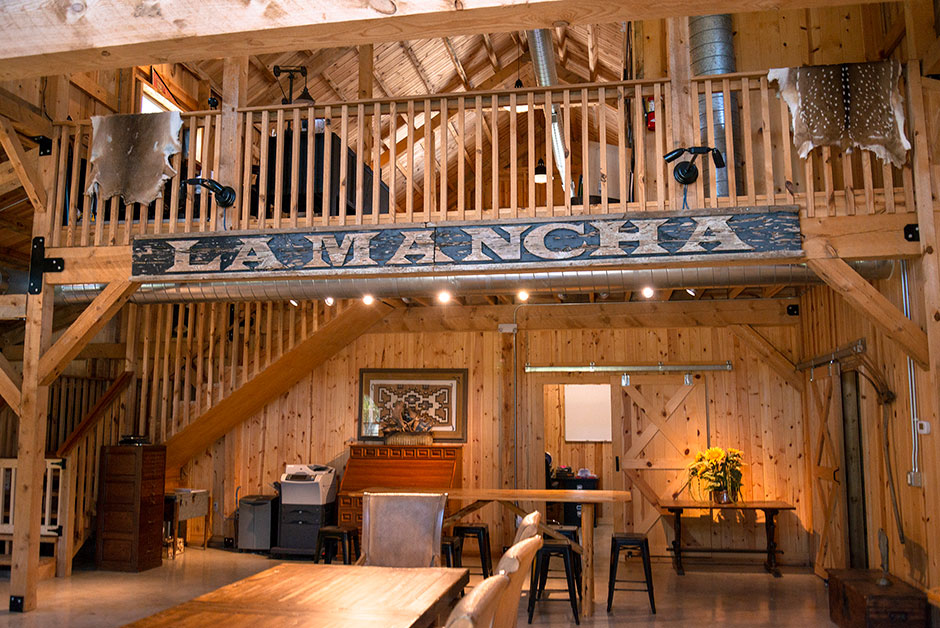
Cedar Eaters’ gorgoeous offices. The administration area overlooks the sitting area and kitchen.
The thing about cedar
So what’s so bad about cedar trees? The short answer: they’re really good at retaining water. Cedar trees are known for their ability to thrive in poor quality soil with sparse rainfall.
Spence describes how a cedar tree is built to direct rainwater to its own root system, “If you ever look at a cedar tree – our cedar trees – they’re kind of built like this,” Spence motions a funnel shape with his hands where the branches of the tree are wider at the bottom. “All the branches get smaller as they come up the trunk, right? So when it rains the tree is like a funnel and it catches the water in its branches where it runs down each branch to the trunk of the tree.” Its dense-leaved canopy offers a large surface area to collect rainfall. As a result, very little rainwater reaches the soil surface below. With cedar hogging all of the water, other native grasses and trees are unable to get what they need to survive and thrive.
WE HAVE THIS PROBLEM THAT USED TO BE CONTROLLED BY NATURE OR BY HUMANS AND NOW IT’S NOT.
So why does grass matter? Why not just let cedar take over? The long root systems of native grasses help to hold soil in place, preventing ground erosion. Removing cedars using the mulching method not only helps prevent ground erosion, it improves the health of the grasslands and will increase the underground water supply. Instead of water getting sucked up by the tree’s root system or evaporating from the tree’s canopy, water is filtered through the soil and grass roots and goes back into the water table.
Another very important reason is wildlife diversity. A variety of grasses and other vegetation attracts a wide range of wildlife and promotes a healthy, well-balanced eco-system.
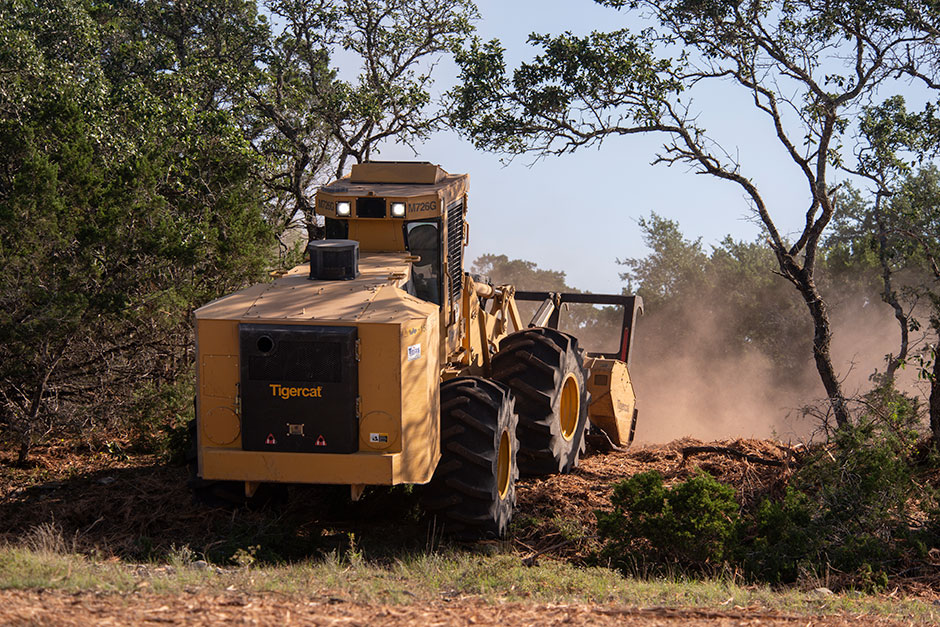
The M726G has high-lift boom geometry for improved performance on sloped terrain, the machine is incredibly agile, allowing the operator to selectively mulch and leave desirable trees undisturbed.
It’s not so much that cedar is an undesirable tree – it just requires some maintenance if you don’t want it to be the only tree on your property. Spence explains that cedar was once controlled by natural disasters.
“Wildfires would run rampant, people would set fires, lightning would strike and fire would just go. Well now that we’ve privatized and subdivided all the land, we have this issue where no one wants to burn anymore; for fear of being sued if it gets out of control. So, we have this problem that used to be controlled by nature or by humans and now it’s not. It doesn’t have fire to keep it at bay so now the only thing people can do is go in there and doze it, shear it or mulch it. We prefer the mulching method because over time the mulch will turn back into soil, and it’s better for the land in the long run.”
Benefits of mulching
Terrain in the Texas Hill Country is rocky, predominantly consisting of limestone. It’s very dry with little topsoil. Unfortunately, the process of turning organic material into topsoil doesn’t happen overnight. Formed from the erosion of rocks and decomposition of organic materials and organisms over hundreds of years, it forces landowners to think long term.
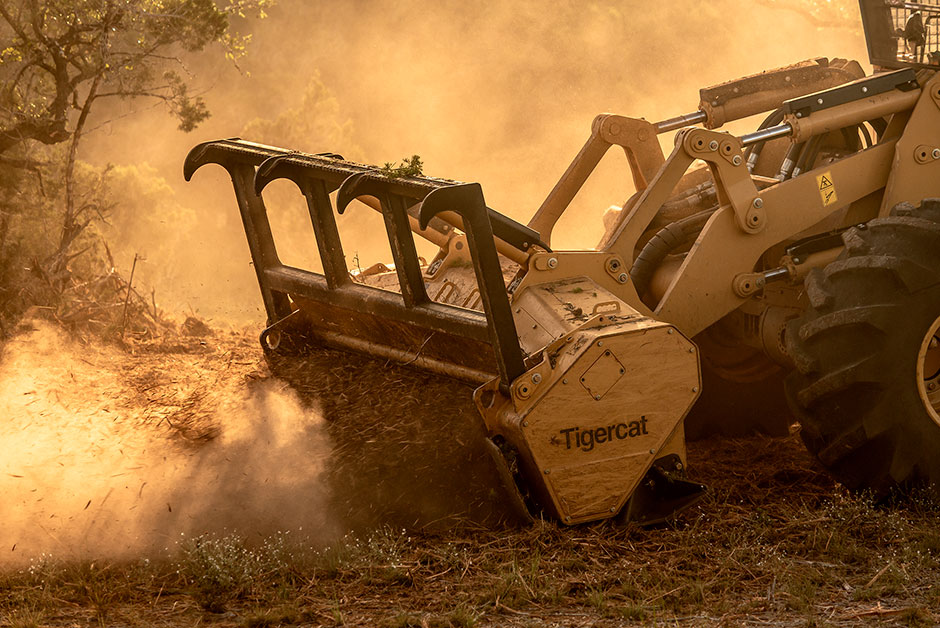
Mulching creates a protective layer over the ground, locking in moisture. It’s full of nutrients, creating the ideal environment for native grasses and desirable trees to thrive.
Mulching essentially helps speed up that decomposition process. Conventional methods such as dozing or burning, strip away all organic material with nothing left to decompose. “Basically, cedar trees are very acidic and limestone is an alkaline agent. When the cedar trees are mulched over limestone, it creates an acidic layer over top of it that will break down over time and create new topsoil. You can see this when you look underneath a cedar tree, there’s actually more topsoil underneath the tree. Well, that’s because the needles are falling down every year, and then it’s actually breaking down and creating topsoil. So the concept is, 50 years from now, the property that has been mulched is going to have more topsoil than the guy that goes out there and dozes it.” Spence also mentions “the benefit of mulching versus dozing is that the regrowth is considerably less with mulching, because dozing disturbs the ground allowing berries that contain the seeds to be replanted.”
Mulching creates a protective layer over the ground, since the machine mostly drives on top of the mulch, leaving much of the land undisturbed. This layer of mulch left behind also locks in moisture. It’s full of nutrients, creating the ideal environment for native grasses and desirable trees to thrive. In turn, this helps prevent soil erosion and can also help to improve the water table by preventing evaporation.
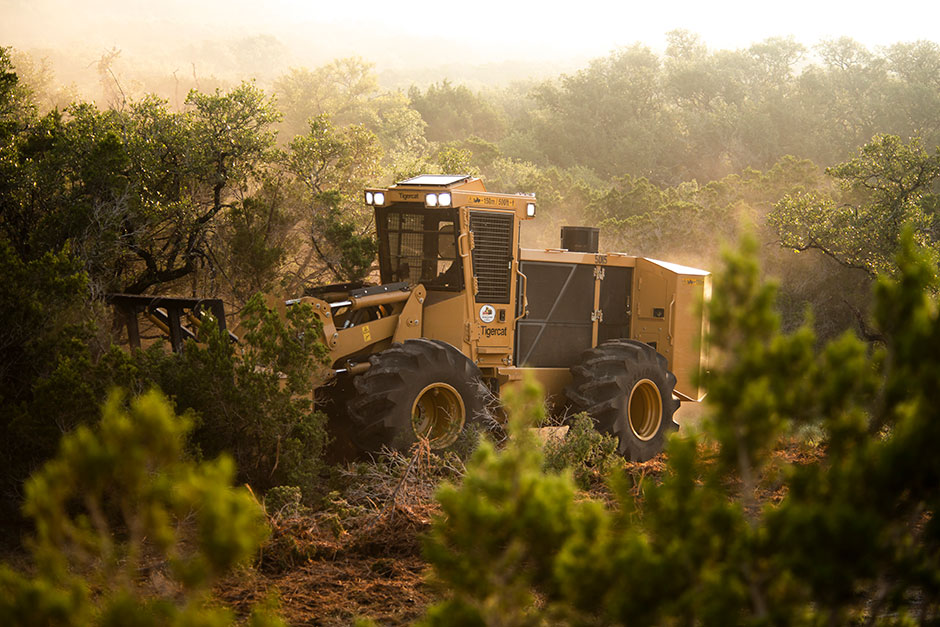
The Tigercat M726G Mulcher tackles brush with ease.
Putting the M726G Mulching Machine to work
When asked about the performance of the new M726G mulcher, Spence tells us that, while they’ve had some growing pains with the 4061 head, “we’ve been really happy with the M726G mulcher. It runs cooler than even the M726Es. It’s got a lot more power. From what I’ve seen, the production rate on the M726G models has improved by at least 25%. The cut rate is quicker, basically. We can go through more land faster with either head on that machine.”
The Hegeners decided to start switching to Tigercat mulching heads because they “feel it will outlast the heads of Tigercat’s competitors.” While they’ve had a few setbacks, Spence tells us that “any issues that have occurred have been addressed quickly with the support of Tigercat and our dealer in Texas, Tejas Equipment.” Acknowledging that any new product is a work in progress, Spence is confident in Tigercat and tells us, “with its robust build and the engineering behind it, the 4061 will no doubt rule the market over time.”
Since 2001, Cedar Eaters has owned a total of 22 mulching machines spanning over five different brands before committing to Tigercat. “The reason we have settled in with Tigercat is their attention to detail and their unwavering drive to improve their products. The support from Tigercat’s ownership, engineers and Tejas Equipment’s technicians as well as our sales rep, Jared Swenson, has been unmatched.”
The next generation
Spence has been a major part of Cedar Eaters since his parents founded it in 2001. While he did not start with the company until 2005, he would often run the machines on weekends at the family ranch in the early years. Spence has grown to develop a great appreciation and passion for what they do and strives to educate those about how to manage cedar in an environmentally friendly way.
The Cedar Eaters name is a trademark. Spence mentions that he hopes to someday, “bottle up what we’re doing here and replicate it in different areas of the country that are battling the same issue with cedar”. With cedar rapidly encroaching on land in New Mexico, Colorado, Oklahoma, Nebraska and Kansas, there’s no denying that there’s opportunity for Cedar Eaters to grow in all of these areas as well.
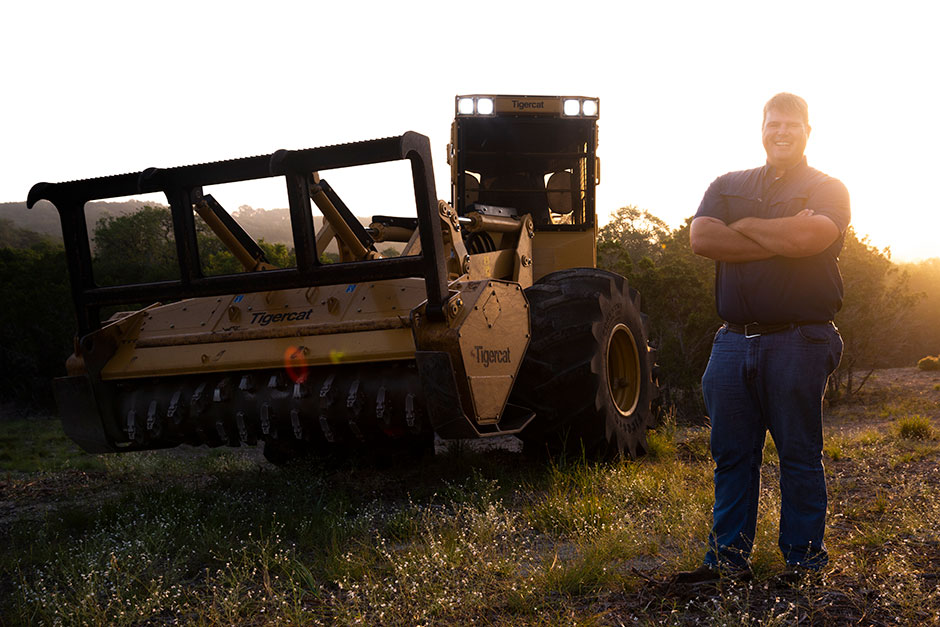
Spence Hegener, Cedar Eaters co-owner and operations manager.










